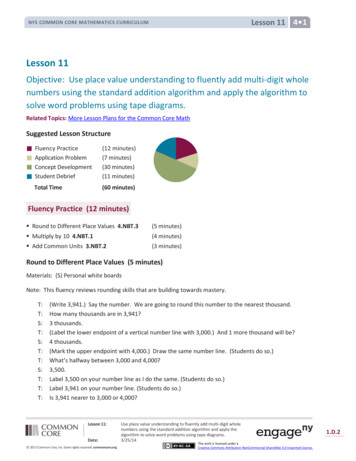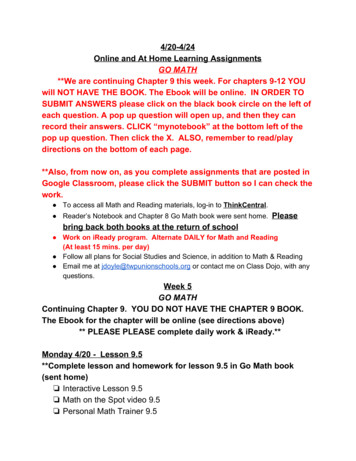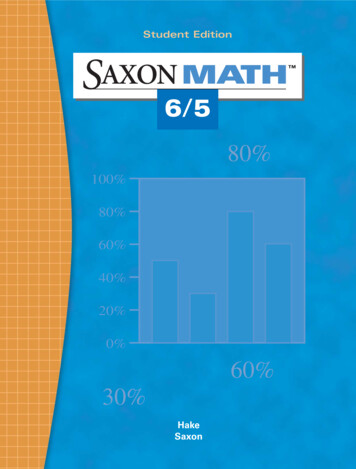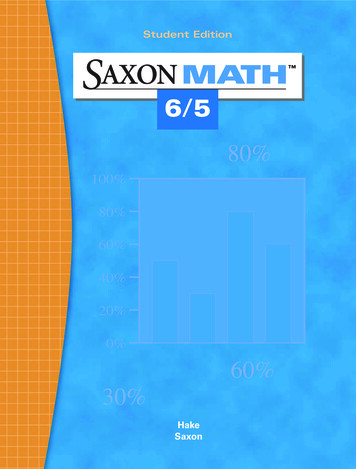
Transcription
Lesson 11NYS COMMON CORE MATHEMATICS CURRICULUMLesson 11Objective: Use place value understanding to fluently add multi-digit wholenumbers using the standard addition algorithm and apply the algorithm tosolve word problems using tape diagrams.Related Topics: More Lesson Plans for the Common Core MathSuggested Lesson StructureFluency Practice Application Problem Concept Development Student Debrief Total Time(12 minutes)(7 minutes)(30 minutes)(11 minutes)(60 minutes)Fluency Practice (12 minutes) Round to Different Place Values 4.NBT.3(5 minutes) Multiply by 10 4.NBT.1(4 minutes) Add Common Units 3.NBT.2(3 minutes)Round to Different Place Values (5 minutes)Materials: (S) Personal white boardsNote: This fluency reviews rounding skills that are building towards mastery.T:T:S:T:S:T:T:S:T:T:T:(Write 3,941.) Say the number. We are going to round this number to the nearest thousand.How many thousands are in 3,941?3 thousands.(Label the lower endpoint of a vertical number line with 3,000.) And 1 more thousand will be?4 thousands.(Mark the upper endpoint with 4,000.) Draw the same number line. (Students do so.)What’s halfway between 3,000 and 4,000?3,500.Label 3,500 on your number line as I do the same. (Students do so.)Label 3,941 on your number line. (Students do so.)Is 3,941 nearer to 3,000 or 4,000?Lesson 11:Date: 2013 Common Core, Inc. Some rights reserved. commoncore.orgUse place value understanding to fluently add multi-digit wholenumbers using the standard addition algorithm and apply thealgorithm to solve word problems using tape diagrams.3/25/14This work is licensed under aCreative Commons Attribution-NonCommercial-ShareAlike 3.0 Unported License.1.D.2
Lesson 11NYS COMMON CORE MATHEMATICS CURRICULUMT:S:(Write 3,941 .) Write your answer on your board.(Students write 3,941 4,000.)Repeat process for 3,941 rounded to the nearest hundred, 74,621 rounded to the nearest ten thousand, andnearest thousand, 681,904 rounded to the nearest hundred thousand and nearest ten thousand, 681,904rounded to the nearest thousand.Multiply by 10 (4 minutes)Materials: (S) Personal white boardsNote: This fluency will deepen student understanding of base ten units.T:S:T:S:T:T:S:(Write 10 x 100.) Say the multiplication sentence.10 x 10 100.(Write 10 x 1 ten .) On your personal white boards, fill in the blank.(Students write 10 x 1 ten 10 tens.)(Write 10 tens hundred.) On your personal white boards, fill in the blank.(Write ten x ten 1 hundred.) On your boards, fill in the blanks.(Students write 1 ten x 1 ten 1 hundred.)Repeat process for the following possible sequence: 1 ten x 60 , 1 ten x 30 hundreds,1 ten x 900, 7 tens x 1 ten hundreds.Note: Watch for students who say 3 tens x 4 tens is 12 tens rather than 12 hundreds.Add Common Units (3 minutes)Materials: (S) Personal white boardsNote: Reviewing this mental math fluency will prepare students for understanding the importance of thealgorithm.T:S:T:S:T:S:(Project 303.) Say the number in unit form.3 hundreds 3 ones.(Write 303 202 .) Say the addition sentence and answer in unit form.3 hundreds 3 ones 2 hundreds 2 ones 5 hundreds 5 ones.Write the addition sentence on your personal white boards.(Students write 303 202 505.)Repeat process and sequence for 505 404; 5,005 5,004; 7,007 4,004; 8,008 5,005.Lesson 11:Date: 2013 Common Core, Inc. Some rights reserved. commoncore.orgUse place value understanding to fluently add multi-digit wholenumbers using the standard addition algorithm and apply thealgorithm to solve word problems using tape diagrams.3/25/14This work is licensed under aCreative Commons Attribution-NonCommercial-ShareAlike 3.0 Unported License.1.D.3
Lesson 11NYS COMMON CORE MATHEMATICS CURRICULUMApplication Problem (7 minutes)Meredith kept track of the calories she consumed for 3 weeks.The first week, she consumed 12,490 calories, the second week14,295 calories, and the third week 11,116 calories. About howmany calories did Meredith consume altogether? Which ofthese estimates will produce a more accurate answer: roundingto the nearest thousand or rounding to the nearest tenthousand? Explain.NOTES ONMULTIPLE MEANSOF REPRESENTATION:For the application problem, studentsworking below grade level may needfurther guidance in putting togetherthree addends. Help them to break itdown by putting two addends togetherand then adding the third addend tothe total. Use manipulatives todemonstrate.Note: This problem reviews rounding from Lesson 10, but can be used as an extension after the Debrief tosupport the objective of this lesson.Concept Development (30 minutes)Materials: (S) Personal white boardsProblem 1Add, renaming once using disks in a place value chart.T:S:T:S:T:T:S:(Project vertically: 3,134 2,493.) Say this problem with me.Three thousand, one hundred thirty-four plus two thousand, four hundred ninety-three.Draw a tape diagram to represent this problem. What are the two parts that make up the whole?3,134 and 2,493.Record that in the tape diagram.What is the unknown?In this case, the unknown is the whole.Lesson 11:Date: 2013 Common Core, Inc. Some rights reserved. commoncore.orgUse place value understanding to fluently add multi-digit wholenumbers using the standard addition algorithm and apply thealgorithm to solve word problems using tape diagrams.3/25/14This work is licensed under aCreative Commons Attribution-NonCommercial-ShareAlike 3.0 Unported License.1.D.4
Lesson 11NYS COMMON CORE MATHEMATICS CURRICULUMT:T:T:S:T:S:T:MP.1T:T:S:T:S:T:Show the whole above the tape diagram using a bracket and label the unknown quantity with thevariable of a.Draw disks into the place value chart to represent the first part, 3,134. Now, it’s your turn. Whenyou are done, add 2,493 by drawing more disks into your place value chart.(Point to the problem.) 4 ones plus 3 ones equals?7 ones. (Count 7 ones in the chart and record 7 ones in the problem.)(Point to the problem.) 3 tens plus 9 tens equals?12 tens. (Count 12 tens in the chart.)We can bundle 10 tens as 1 hundred. (Circle 10 ten disks, draw an arrow to the hundreds placeand the 1 hundred disk to show the regrouping.)We can represent this in writing. (Write 12 tens as 1 hundred, crossing the line, and 2 tens in thetens column, so that you are writing 12 and not 2 and 1 as separate numbers. Refer to the verticalequation visual above.)(Point to the problem.) 1 hundred plus 4 hundreds plus 1 hundred equals?6 hundreds. (Count 6 hundreds in the chart, and record 6 hundreds in the problem.)(Point to the problem.) 3 thousands plus 2 thousands equals?5 thousands. (Count 5 thousands in the chart, and record 5 thousands in the problem.)Say the whole equation with me: 3,134 plus 2,493 equals 5,627. Label the whole in the tapediagram, above the bracket, with a 5,627.Problem 2Add, renaming in multiple units using the standard algorithm and the place value chart.T:T:(Project vertically: 40,762 30,473.)With your partner, draw a tape diagram to model this problem labeling the two known parts andthe unknown whole, using B to represent the whole.Circulate and assist students.T:T:S:T:With your partner, write the problem and draw disks for the first addend in your chart.Then, draw disks for the second addend.(Point to the problem.) 2 ones plus 3 ones equals?5 ones. (Students count the disks to confirm 5 ones and write 5 in the ones column.)6 tens plus 7 tens equals?Lesson 11:Date: 2013 Common Core, Inc. Some rights reserved. commoncore.orgUse place value understanding to fluently add multi-digit wholenumbers using the standard addition algorithm and apply thealgorithm to solve word problems using tape diagrams.3/25/14This work is licensed under aCreative Commons Attribution-NonCommercial-ShareAlike 3.0 Unported License.1.D.5
Lesson 11NYS COMMON CORE MATHEMATICS CURRICULUMS:T:13 tens. We can group 10 tens to make 1 hundred. We don’t write two digits in one column.We can change 10 tens for 1 hundred leaving us with 3 tens.(Regroup the disks.) Watch me as I record the larger unit using the addition algorithm.First, record the 1 below the digits in the hundreds place then record the 3 in the tens, so that you arewriting 13, not 3 then 1.T:7 hundreds plus 4 hundreds plus 1 hundred equals 12 hundreds. Discuss with your partner how torecord this.Continue adding, regrouping, and recording across other units. T:Say the whole equation with me. 40,762 plus 30,473 equals 71,235. Label the whole in the bardiagram with 71,235, and write B 71,235.Problem 3Add, renaming multiple units using the standard algorithm.T:T:T:S:(Project: 207,426 128,744.)Draw a tape diagram to model this problem. Record the numbers on yourboard.With your partner, add units right to left, regrouping when necessary usingthe addition algorithm.207,426 128,744 336,170.Problem 4Solve one-step word problem using standard algorithm modeled with a tape diagram.The Lane family took a road trip. During the first week, theydrove 907 miles. The second week they drove the sameamount as the first week plus an additional 297 miles. Howmany miles did they drive during the second week?T:S:T:S:T:What information do we know?We know they drove 907 miles the first week.We also know they drove 297 miles more during thesecond week than the first week.What is the unknown information?We don’t know the total miles they drove in thesecond week.Draw a tape diagram to represent the amount of milesin the first week, 907 miles. Since the Lane familydrove an additional 297 miles in the second week,extend the bar for 297 more miles.What does the bar represent?Lesson 11:Date: 2013 Common Core, Inc. Some rights reserved. commoncore.orgNOTES ONMULTIPLE MEANSOF ACTIONAND EXPRESSION:ELLs benefit from further explanationof the word problem. Have aconversation around the following:“What do we do if we don’tunderstand a word in the problem?What thinking can we use to figure outthe answer anyway?”In this case, students do not need toknow what a road trip is in order tosolve. Discuss, “How is the tapediagram helpful to us?” It may behelpful to use the RDW approach:Read important information, draw apicture, and write an equation to solve.Use place value understanding to fluently add multi-digit wholenumbers using the standard addition algorithm and apply thealgorithm to solve word problems using tape diagrams.3/25/14This work is licensed under aCreative Commons Attribution-NonCommercial-ShareAlike 3.0 Unported License.1.D.6
Lesson 11NYS COMMON CORE MATHEMATICS CURRICULUMS:T:T:S:T:S:T:S:The number of miles they drove in the secondweek.Use a bracket to label the unknown as M formiles.How do we solve for M?907 297 M. (Check student algorithmsto see they are recording the regrouping of10 of a smaller unit for 1 larger unit.)Solve. What is M?M equals 1,204. (Write M 1,204.)Write a sentence that tells your answer.The Lane family drove 1,204 miles during thesecond week.Problem Set (10 minutes)Students should do their personal best to complete theProblem Set within the allotted 10 minutes. For someclasses, it may be appropriate to modify the assignmentby specifying which problems they work on first. Someproblems do not specify a method for solving. Studentssolve these problems using the RDW approach used forApplication Problems.Student Debrief (11 minutes)Lesson Objective: Use place value understanding tofluently add multi-digit whole numbers using the standardaddition algorithm and apply the algorithm to solve wordproblems using tape diagrams.Invite students to review their solutions for the ProblemSet and the totality of the lesson experience. They shouldcheck work by comparing answers with a partner beforegoing over answers as a class. Look for misconceptions ormisunderstandings that can be addressed in the Debrief.Guide students in a conversation to debrief the ProblemSet. You may choose to use any combination of thequestions below to lead the discussion. When we are writing a sentence to express ouranswer, what part of the original problem helpsus to tell our answer using the correct words andcontext?Lesson 11:Date: 2013 Common Core, Inc. Some rights reserved. commoncore.orgUse place value understanding to fluently add multi-digit wholenumbers using the standard addition algorithm and apply thealgorithm to solve word problems using tape diagrams.3/25/14This work is licensed under aCreative Commons Attribution-NonCommercial-ShareAlike 3.0 Unported License.1.D.7
Lesson 11NYS COMMON CORE MATHEMATICS CURRICULUM What purpose does a tape diagram have? How does it support your work?What does a variable, like the letter B in Problem 2, help us do when drawing a tape diagram?I see different types of tape diagrams drawn for Problem 3. Some drew one bar with two parts.Some drew one bar for each addend, and put the bracket for the whole on the right side of bothbars. Will these diagrams result in different answers? Explain.In Problem 1, what did you notice was similar and different about the addends and the sums forParts (a), (b), and (c)?If you have 2 addends, can you ever have enough ones to make 2 tens, or enough tens to make 2hundreds, or enough hundreds to make 2 thousands? Try it out with your partner. What if youhave 3 addends?In Problem 1, each unit used the numbers 2, 5, and 7 once, but the sum doesn’t show repeatingdigits. Why not?How is recording the regrouped number in the next column of the addition algorithm related tobundling disks?Have students revisit the Application Problem and solve for the actual amount of caloriesconsumed. Which unit when rounding provided an estimate closer to the actual value?Exit Ticket (3 minutes)After the Student Debrief, instruct students to complete the Exit Ticket. A review of their work will help youassess the students’ understanding of the concepts that were presented in the lesson today and plan moreeffectively for future lessons. You may read the questions aloud to the students.Lesson 11:Date: 2013 Common Core, Inc. Some rights reserved. commoncore.orgUse place value understanding to fluently add multi-digit wholenumbers using the standard addition algorithm and apply thealgorithm to solve word problems using tape diagrams.3/25/14This work is licensed under aCreative Commons Attribution-NonCommercial-ShareAlike 3.0 Unported License.1.D.8
Lesson 11 Problem SetNYS COMMON CORE MATHEMATICS CURRICULUMNameDate1. Solve the addition problems below using the standard algorithm.a.6, 3 1 1 d.b.2 6 86, 3 1 45 2, 0 9 8 j.6, 0 4 8527 275 752 Lesson 11:Date: 2013 Common Core, Inc. Some rights reserved. commoncore.orgc. 1, 2 6 8e.h.6, 3 1 4 f.8, 3 1 4i.3 4, 6 9 81, 2 6 81 2, 3 7 8 2, 4 9 3 2, 4 9 3g.6, 3 1 15, 4 6 35 4 4, 8 1 1 3 5 6, 4 4 5 7 1, 8 4 0k.38,193 6,376 241,457 Use place value understanding to fluently add multi-digit wholenumbers using the standard addition algorithm and apply thealgorithm to solve word problems using tape diagrams.3/25/14This work is licensed under aCreative Commons Attribution-NonCommercial-ShareAlike 3.0 Unported License.1.D.9
NYS COMMON CORE MATHEMATICS CURRICULUMLesson 11 Problem SetDirections: Draw a tape diagram to model the following problems. Use numbers and words to explain yourwork.2. In September, Liberty Elementary School collected 32,537 cans for a fundraiser. In October, theycollected 207,492 cans. How many cans were collected during September and October?3. A baseball stadium sold some burgers: 2,806 were cheeseburgers and 1,679 burgers didn’t have cheese.How many burgers did they sell in all? Use a tape diagram to show your work.4. On Saturday night, 23,748 people attended the concert. On Sunday, 7,570 more people attended theconcert than on Saturday. How many people attended the concert on Sunday?Lesson 11:Date: 2013 Common Core, Inc. Some rights reserved. commoncore.orgUse place value understanding to fluently add multi-digit wholenumbers using the standard addition algorithm and apply thealgorithm to solve word problems using tape diagrams.3/25/14This work is licensed under aCreative Commons Attribution-NonCommercial-ShareAlike 3.0 Unported License.1.D.10
NYS COMMON CORE MATHEMATICS CURRICULUMNameLesson 11 Exit TicketDate1. Find the sums of the following:a. 2 3, 6 0 7 2, 3 0 7b. 3, 9 4 8 278c. 5,983 2,0972. The office supply closet had 25,473 large paperclips, 13,648 medium paperclips, and 15,306 smallpaperclips. How many paperclips were in the closet?Lesson 11:Date: 2013 Common Core, Inc. Some rights reserved. commoncore.orgUse place value understanding to fluently add multi-digit wholenumbers using the standard addition algorithm and apply thealgorithm to solve word problems using tape diagrams.3/25/14This work is licensed under aCreative Commons Attribution-NonCommercial-ShareAlike 3.0 Unported License.1.D.11
Lesson 11 HomeworkNYS COMMON CORE MATHEMATICS CURRICULUMNameDate1. Solve the addition problems below using the standard algorithm.a.7,909b. 1,044d.289,20583,906 35,808Lesson 11:Date: 2013 Common Core, Inc. Some rights reserved. commoncore.orgc.e.547,982f. 114,849h.289,999 91,849Use place value understanding to fluently add multi-digit wholenumbers using the standard addition algorithm and apply thealgorithm to solve word problems using tape diagrams.3/25/14827,909 42,989 9,740 11,845g.27,909258,983 121,897i.754,900 245,100This work is licensed under aCreative Commons Attribution-NonCommercial-ShareAlike 3.0 Unported License.1.D.12
NYS COMMON CORE MATHEMATICS CURRICULUMLesson 11 HomeworkDirections: Draw a tape diagram to model the following problem. Use numbers and words to explain yourwork.2. At the zoo, Brooke learned that one of rhinos weighed 4,897 pounds, one of the giraffes weighed 2,667pounds, one of the African elephants weighed 12,456 pounds, and one of the Komodo dragons weighed123 pounds.a. What is the combined weight of the zoo’s African elephant and the giraffe?b. What is the combined weight of the zoo’s African elephant and the rhino?c. What is the combined weight of the zoo’s African elephant, the rhino, and the giraffe?d. What is the combined weight of the zoo’s Komodo dragon and the rhino?Lesson 11:Date: 2013 Common Core, Inc. Some rights reserved. commoncore.orgUse place value understanding to fluently add multi-digit wholenumbers using the standard addition algorithm and apply thealgorithm to solve word problems using tape diagrams.3/25/14This work is licensed under aCreative Commons Attribution-NonCommercial-ShareAlike 3.0 Unported License.1.D.13
T: We can bundle 10 tens as 1 hundred. (Circle 10 ten disks, draw an arrow to the hundreds place and the 1 hundred disk to show the regrouping.) T: We can represent this in writing. (Write 12 tens as 1 hundred, crossing the line, and 2 tens in the tens column, so that you are writing 12 and not 2 and 1 as separate numbers. Refer to the vertical











